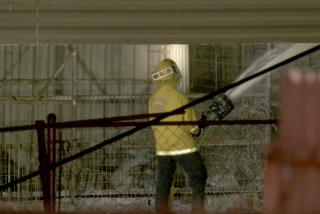A Victim’s Story: ‘Pain Just Kept Getting Worse’
- Share via
TUCSON, Ariz. — Those who’ve been bitten by a rattlesnake say it’s harrowing.
Bud Seitz, 54, a locomotive engineer, watched a TV news report on the antivenin scarcity and shuddered. In his mind, he saw a fat, green, three-foot Mojave, its fangs embedded in his bare right calf.
“Monday, February the 13th, 1995, 1 o’clock in the afternoon,” he said.
He was riding his bicycle in a desert park 10 miles east of here and stopped to take a photo. He stepped back, back, back, framing the shot. Behind him, the Mo’ was sunning itself, out of hibernation in the unseasonably warm air.
The bite: “It’s the closest thing I can think of to getting shot. The strike was so powerful, it felt like someone had taken a two-by-four with a couple of big nails sticking out of it and hit me as hard as they could on the back of my leg.”
Stunned, he limped to the road and sat down, his calf starting to swell. Soon came the pain--”a throbbing, crushing, vise-like pain that just kept getting worse.”
In the ambulance: “Now the pain is an intense burning, like someone’s taking the skin and peeling it off and taking a blowtorch and frying my leg. I’m thrashing around, yelling. They’re doing all they can to hold me down.”
The toxic cocktail shot into him by the Mo’ was ravaging his body in a half-dozen ways, including causing major internal bleeding.
In the emergency room, his leg bloated, his abdomen and chest grotesquely swollen, the skin black: “The nurse is yelling out my blood pressure; it’s going like 90 over something, 85 over something, 70 over something. . . .”
At 50 over 30, four IV tubes in him: “The doctor yells out, “I need another 50 cc’s of [something], he’s gone dusky on me!’ Well, I didn’t know what ‘dusky’ meant until the next day, when I asked him. And he said, ‘Dusky is the color of a cadaver when all the blood and life is out of it.’ He said at 50 over 30, I had a minute or two left.”
The ER staff got his pressure up, then administered 51 vials of antivenin over several hours, until finally he had enough in him to counteract the venom. It took him two months to recuperate.
Toxicologist Jude McNally, manager of the Arizona Poison and Drug Information Center, said Seitz’s case was unusually severe but not unique. “We see a couple of those every year,” he said. “We see some that actually get up into 70 or 80 vials.” In a typical case, he said, 20 to 30 vials are enough to stop the venom’s progression.
More to Read
Sign up for Essential California
The most important California stories and recommendations in your inbox every morning.
You may occasionally receive promotional content from the Los Angeles Times.













